
List of trucking industry terms in the United States
Encyclopedia
| Index of General |
|---|
|
| Index of Drivers and carriers |
|---|
|
|
| Index of Vehicles |
|---|
|
|
| Index of Vehicle parts |
|---|
|
|
| Index of Trailers |
|---|
|
|
| Index of Trailer configurations |
|---|
|
|
A specialized set of jargon
Jargon
Jargon is terminology which is especially defined in relationship to a specific activity, profession, group, or event. The philosophe Condillac observed in 1782 that "Every science requires a special language because every science has its own ideas." As a rationalist member of the Enlightenment he...
describe the tools, equipment, and employment sectors used in the trucking industry in the United States
Trucking industry in the United States
The trucking industry involves the transport and distribution of commercial and industrial goods using commercial motor vehicles . In this case, CMVs are most often trucks; usually semi trucks, box trucks, or dump trucks...
. Some terms may be used within other English-speaking countries, or within the freight industry in general (air, rail, ship, and manufacturing). For example, shore power is a term borrowed from shipping terminology, in which electrical power is transferred from shore to ship, instead of the ship relying upon idling its engines. Drawing power from land lines is more efficient than engine idling and eliminates localized air pollution. Another borrowed term is "landing gear
Landing Gear
Landing Gear is Devin the Dude's fifth studio album. It was released on October 7, 2008. It was his first studio album since signing with the label Razor & Tie. It features a high-profile guest appearance from Snoop Dogg. As of October 30, 2008, the album has sold 18,906 copies.-Track...
" (from the aviation
Aviation
Aviation is the design, development, production, operation, and use of aircraft, especially heavier-than-air aircraft. Aviation is derived from avis, the Latin word for bird.-History:...
industry), which refers to the legs which support the front end of a semi-trailer
Semi-trailer
A semi-trailer is a trailer without a front axle. A large proportion of its weight is supported by a road tractor, a detachable front axle assembly known as a dolly, or the tail of another trailer...
when it is not connected to a semi-truck
Tractor unit
A tractor unit, prime mover , road tractor, or traction unit is a heavy-duty commercial vehicle within the large goods vehicle category, usually with a large displacement diesel engine, and several axles. The tractor unit serves as a method of moving trailers...
. Some nicknames are obvious wordplay, such as "portable parking lot", in reference to a truck that carries automobiles.
General
Bill of lading (BOL, BL, B/L):- A paper document between a shipper and a carrier acknowledging the receipt of goods for transport. Usually describes the nature of the cargo; hazardous materials classification (if any); amount of cargo by weight, size, and/or number of pallets, boxes, barrels, etc; and the origin and destination of the cargo.
Bobtailing:Operating a tractor unit with no trailer attached.
Broker:A person or company that arranges for the truck transportation of cargo belonging to others, using for-hire carriers to provide the actual truck transportation.
Bulk cargo:
- Large quantities of undivided or unpackaged cargo, such as a tank trailer filled with gasoline.
Bulk freight:See bulk cargo.
Cabotage:
- The rights of a country to control the movement of vessels and vehicles transporting goods or passengers within its borders. May refer to the transportation of cargo between two points within a country by a vehicle registered in another country.
Cargo:See freight.
Consignee:
- The person or entity transferring legal responsibility or ownership of the cargo (or consignment) from the carrier.
Consignment:
- An agreement between a consignee and a consignor in which the goods are taken responsibility for and transported by a third party, the carrier. May also simply refer to the consigned goods (i.e., the cargo).
Consignor:
- The person or entity transferring legal responsibility or ownership of the cargo (or consignment) to the carrier.
Deadheading:Operating a truck with an empty trailer.
Demurrage: A charge by the carrier (any mode) for excess retention of shipping vessel, container, trailer, etc; caused by untimely unloading
Electronic on-board recorder (EOBR):
- An device hooked into the truck which transmits useful management information such as truck location, speed, and idle time.
Float shifting:Shifting gears without using the clutch pedal. Also called "slip shifting" or "dead sticking."

- The materials or goods being transported.
Hazardous materials (Haz-mat):
- Explosive, flammable, poisonous or otherwise potentially dangerous cargo. Large amounts or especially hazardous cargo are required to be placardPlacardA placard is a notice installed in a public place, like a small card, sign, or plaque. It can be attached to or hung from a vehicle or building to indicate information about the vehicle operator or contents of a vehicle or building.- Buildings :...
ed under haz-mat regulations.
Intermodal:
- A single trailer or container that encounters multiple forms of transportation along its route, such as truck/ship/rail.
Just-in-time:
- A method of inventory control in which warehousing is either nonexistent or kept to a minimum. The freight arrives "just in time", and only when it is needed.
Log book:
- A form which describes the working duties of truck drivers for each 24-hour period.
Manifest:A document that describes the contents of a shipment in greater detail than a bill of lading. Commonly used as a checklist during unloading.
Operating authority:Motor carriers for-hire must apply for the authority to engage in interstate commerce with the Federal Motor Carrier Safety Administration
Federal Motor Carrier Safety Administration
The Federal Motor Carrier Safety Administration , established January 1, 2000, regulates the trucking industry in the United States. FMCSA is headquartered in Washington, DC and employs more than 1,000 people in all 50 States and the District of Columbia...
.
Oversize load:
- A unit of cargo that is larger than the legally defined limits for width, length, height, and/or weight; it cannot be broken down into smaller units.
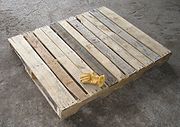
- A wooden (or sometimes plastic) platform on which boxes or cargo are stacked and sometimes shrink-wrapped. Usually refers to the entire palletized stack of boxes, although it can refer to the platform itself.
Progressive shifting:
- A method of shifting gears that optimizes the power range of the engine, which in turn optimizes fuel efficiency.
Receiver:Consignee, importer, or buyer (who may or may not be the same) named in the bill of lading as the party responsible for receiving a shipment.
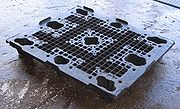
Shore power:
- A land-based electric power supply for trucks. Eliminates the need for engine idling while parked, and in the case of IdleAireIdleAireIdleAire Technologies Corporation was a company that provided in-cab services to truckers via centralized systems at truck stops around the United States...
, also supplies land-based climate control within the truck cab, as well as internet and TV access.
Terminal:A dock or hub where freight either originates, terminates, or is handled in the transportation process; or a location where motor carriers maintain operating facilities.
Tractor:
- A semi-truck (powered unit) used to pull a load or semi-trailer (unpowered unit) by means of a fifth wheel mounted over the rear axle(s) in a semi-truck/semi-trailer combination.
Truck Stop Electrification (TSE): See shore power.
Drivers and carriers
Common carrier:- A for-hire carrier that is obligated to serve the general public.
Company driver:Employee of a carrier who is assigned to drive company-owned trucks.
Contract carrier:A for-hire carrier contracted to one particular shipper. A contract carrier enters into a contract whose terms are negotiated between a specific carrier and specific customer.
Dedicated route:A driver or carrier who transports cargo between regular, prescribed routes. Regular route drivers usually are at home on regular intervals, given the scheduled nature of their routes.
For-hire carrier:A licensed carrier that holds itself out to hire under either a public tariff for the general public (for-hire common carrier) or under a contract filed with a specific shipper (contract carrier). For-hire carriers must apply for operating authority with the Federal Motor Carrier Safety Administration.
Irregular route:See over-the-road.
Less-than-truckload (LTL):
- A driver or carrier who specializes in, or a load composed of many different types of cargo, each typically weighing less than 10000 pounds (4,535.9 kg), with many different destinations. Generally involves the use of terminal facilities to break and consolidate shipments. A LTL driver normally has a dedicated or regional route.
Long-haul:See over-the-road.
Motor carrier:A person or company providing transportation of property or passengers using commercial motor vehicles.
Over-the-road (OTR):A driver or carrier who transports cargo to any place at any time, without prescribed schedules or routes. Long-Haul OTR involves being away for weeks, or months at a time, often cross-country or international (Canada and Mexico), given the unscheduled nature of their routes.
Owner-operator (O/O):
- Self-employedSelf-employmentSelf-employment is working for one's self.Self-employed people can also be referred to as a person who works for himself/herself instead of an employer, but drawing income from a trade or business that they operate personally....
independent drivers who operate privately owned or leaseLeaseA lease is a contractual arrangement calling for the lessee to pay the lessor for use of an asset. A rental agreement is a lease in which the asset is tangible property...
d trucks, as opposed to a company driver.
Private carrier:A not-for-hire carrier contracted to or owned by a shipper that does not offer services to the general public, and operates primarily to transport its own goods. Private carriers are not required to obtain operating authority by the Federal Motor Carrier Safety Administration.
Regional route:A driver or carrier who transports cargo in a limited geographical area, usually within a certain radius of one's own home or company terminal, and may or may not maintain a schedule.
Regular route:See dedicated route.
Team drivers:A team of two or more drivers who ride together and drive the same truck in shifts, essentially allowing the truck to remain in motion almost constantly. Primarily used for time-sensitive freight.
Truckload (TL):
- A driver or carrier who specializes in, or a load composed of one type of cargo, typically weighing more than 10000 pounds (4,535.9 kg), with normally one destination. A truckload driver is normally an over-the-road driver with an irregular route.
Vehicles
Big rig:See semi-truck.Big truck:See semi-truck.
Bobtail:Either a tractor without a trailer, or a box truck. In verb form, this also refers to operating a truck without a trailer.
Bob truck:See box truck.
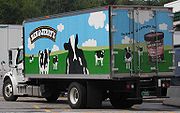
- A smaller, single-unit, non-articulated truck, usually having between 6 and 10 wheels. Often incorrectly called a 'bobtail.'
Cab over:
- A short, box-shaped tractor with no hood, and a steep vertical front. The "cab" rides "over" the engine and front steering axle. Used when a shorter wheelbaseWheelbaseIn both road and rail vehicles, the wheelbase is the distance between the centers of the front and rear wheels.- Road :In automobiles, the wheelbase is the horizontal distance between the center of the front wheel and the center of the rear wheel...
is needed.
Combination vehicle:A vehicle composed of two or more separate units, a tractor
Tractor unit
A tractor unit, prime mover , road tractor, or traction unit is a heavy-duty commercial vehicle within the large goods vehicle category, usually with a large displacement diesel engine, and several axles. The tractor unit serves as a method of moving trailers...
(powered unit, semi-truck) and a trailer
Semi-trailer
A semi-trailer is a trailer without a front axle. A large proportion of its weight is supported by a road tractor, a detachable front axle assembly known as a dolly, or the tail of another trailer...
(unpowered unit, semi-trailer).
Conventional truck:
- A tractor featuring a forward engine and a cab situated in front of the rear axle, with a convential hood configuration.
Day cab: A truck cab without a sleeper berth.
Dump truck:
- Usually refers to a straight truck with a bucket-like cargo area, although it can refer to a semi-truck with a dump trailer.
Eighteen-wheeler: This term is derived from the number of wheels that the typical OTR tractor-trailer configuration has. See also semi-truck.
Semi-truck:
- An articulatedArticulated vehicleAn articulated vehicle is a vehicle which has a permanent or semi-permanent pivoting joint in its construction, allowing the vehicle to turn more sharply. There are many kinds of articulated vehicles, from heavy equipment to buses, trams and trains...
(jointed) combination vehicle, commonly composed of a 10-wheeled tractor and an 8-wheeled trailer.
Straight truck:See box truck.
Tractor-trailer:See semi-truck.
Truck crane: A special truck (carrier) with a permanently mounted crane (upper). This design allows faster moves from site to site than conventional cranes.
Vehicle parts
- See also Semi-trailer truck#Construction for a diagram of truck parts.
Baffle:A partition or separator within a liquid tank, used to inhibit the flow of fluids within the tank. During acceleration, turning, and braking, a large liquid-filled tank may produce unexpected forces on the vehicle due to the inertia
Inertia
Inertia is the resistance of any physical object to a change in its state of motion or rest, or the tendency of an object to resist any change in its motion. It is proportional to an object's mass. The principle of inertia is one of the fundamental principles of classical physics which are used to...
of liquids.
Bulkhead:A strong wall-like structure placed at the front of a flatbed trailer (or on the rear of the tractor) used to protect the driver against shifting cargo during a front-end collision. May also refer to any separator within a dry or liquid trailer (also called a baffle for liquid trailers) used to partition the load.
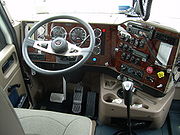
Cab:See cabin.
Cabin:
- The interior of a truck where the driver sits to operate the vehicle.
Cheater axle:See lift axle.
Engine brake:
- A braking system that utilizes the back pressure from the engine's pistons to slow down the vehicle. Commonly used to prevent heavy trucks from accelerating out of control while driving on steep downhill grades.
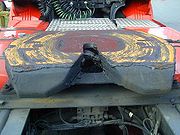
- A pivoting platform on the rear of a truck tractor, used to support the front end of the trailer being towed that contains locking jaws that engage the trailer kingpin.
Glad hands:Interlocking connectors attached to air hoses that supply air from the tractor to the trailer for air brakes.
Headache rack:See bulkhead.
Jake brake:
- A popular brand of engine brake. See also engine brake.
Kingpin:A large pin, underneath the front of a trailer, which interlocks with the fifth wheel.
Landing gear:A set of retractable, crank-up legs that support the front of a trailer when it is not connected to a tractor.
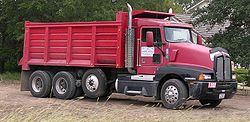
Retarder:
- A device used to assist braking that does not use friction. such as engine braking or axle-mounted electromagnetic retarders. See also engine brake.
Sleeper berth:The portion of the truck's interior designated for sleeping, legally must contain a bed.
Super single: A single, larger wheel, substituted for a tandem assembly. The main benefit of a super single is a reduction in weight; combined with lower rolling resistance the super single promises better fuel economy. The disadvantage is the lack of tire redundancy from which tandem wheels benefit, as tire failure can disable the vehicle.
Tandem:May refer to the set of dual wheels or dual axles commonly found on large trucks. The word tandem itself means "having parts arranged one behind another".
Tandem axle:A pair of axles spaced close together.
Tandem wheel:A set of dual wheels (on pickup trucks, known as a dually). A tandem assembly is a redundant backup system, if one tire fails the second will maintain support, allowing the vehicle to keep driving.
Trailers
Auto transport:A specialized trailer or truck/trailer combination used for transporting passenger vehicles.Belly dump:See bottom dump.

Bull wagon: See livestock.
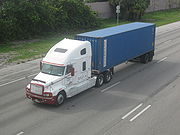
Chip van: specially designed bulk dry van with open top for wood byproducts.
Container:
- A simple, enclosed box of standardized sizes, used for intermodal transport.
Container skeletal carrier:A skeletal trailer composed of a simple chassis for the mounting of an intermodal container.
Covered wagon: A flatbed with specially fitted side plates and curved ribs supporting a tarp covering, commonly referred to as a "side kit". Named for the resemblance to horse-drawn covered wagon
Covered wagon
The covered wagon, also known as a Prairie schooner, is an icon of the American Old West.Although covered wagons were commonly used for shorter moves within the United States, in the mid-nineteenth century thousands of Americans took them across the Great Plains to Oregon and California...
s.
Curtainside:Can be either a dry box with tarp sides, or a flatbed with a movable frame of squared ribs supporting a tarp.
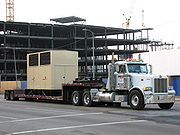
Double decker:A specialized trailer with 2 floors to allow for more cargo space.
Double dropdeck:A flatbed with the lowest deck. Featuring a raised step at the front, where the trailer attaches to the fifth wheel, and at the back, where the wheel wells are located. Normally used for oversize/overheight loads.

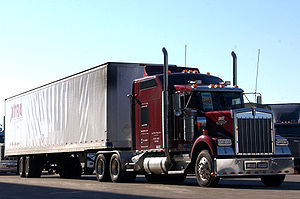
Dry box:See dry van.
Dry bulk:A variation of the liquid tank trailer, with a funnel-shaped bottom, used for hauling bulk quantities of dry powder (sometimes called bulk pneumatic). Usually loaded through holes in the top, unloaded through the bottom or through pneumatic force.
Dry van:A simple, enclosed non-climate controlled rectangular trailer that carries general cargo, including food and other products that do not require refrigeration. Usually loaded/unloaded through the rear doors, requiring elevated access for forklifts to enter the trailer.
Dump:A bucket-like trailer with an open top for loading, commonly used for hauling bulk quantities of dirt, rock, gravel, etc.
Flatbed:A flat trailer with no enclosure or doors. Can be loaded/unloaded from the sides or above, and does not require elevated access for forklifts.
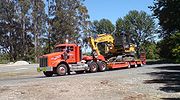
- A specialized lowered flatbed trailer featuring an arched coupling arm, normally used for oversize/overweight loadOversize/overweight loadIn road transport, an oversize load is a load that exceeds the standard or ordinary legal size and/or weight limits for a specified portion of road, highway or other transport infrastructure, such as air freight or water freight. There are also load per axle limits...
s.
Grain:A rectangular enclosure with an open top for bulk loading, covered with a tarp, and a funnel shaped bottom for unloading grain, fertilizer, etc.
Hopper:See grain.
Livestock:A rectangular enclosure with sides featuring numerous ventilation holes, an interior with multiple levels, and usually a ramp in the rear for loading/unloading. Used for hauling cows, pigs, sheep, etc.
Live-bottom: A dry van with solid or openable roof with a moveable mechanized floor for unloading.
Logger:See timber.
Lowboy:See double dropdeck, or gooseneck lowboy.
Platform:See flatbed.
Portable parking lot: See auto transport.
Pup:A trailer between 26 feet (7.9 m) and 29 feet (8.8 m) long that can be used singularly as a delivery trailer in congested areas or in combination with another trailer for over the road.
Rear dump:A dump with a rear pivot point allowing the front of the cargo area to be raised vertically for unloading through the rear.
Reefer:See refrigerated van.

Side dump:A dump with front and rear pivot points allowing the cargo area to tilt sideways for unloading.
Side kit:See covered wagon.
Sideloader:A specialized container trailer with cranes on the front and rear to allow for on-the-spot loading and unloading.

Stepdeck:See dropdeck.
Tank:
- An enclosed cylinder-shaped tank used for hauling bulk quantities of liquid.
Tanker:See tank.
Timber:A specialized trailer, used for transporting logs, consisting of a basic chassis with vertical stakes along the sides to hold the logs in place.
Trailer configurations
'B' train Double: A special set-of-doubles: the second (usually shorter) trailer is hooked directly to the first via a fifth wheel on the rear of the first one (two semis).
Standard: A single trailer. Common dimensions range from 45 feet (13.7 m) to 53 feet (16.2 m) long, and up to 13.5 feet (4.1 m) tall.
Triple: A combination of three pup trailers. Legal in 17 states, usually restricted to major highways, toll roads, or freeways.
Turnpike Double: A combination of two standard trailers. Legal in 18 states, these unusually long combinations are usually restricted to toll roads or freeways.

